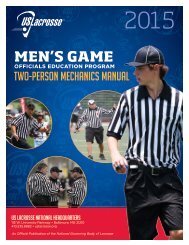BASKETBALL
You also want an ePaper? Increase the reach of your titles
YUMPU automatically turns print PDFs into web optimized ePapers that Google loves.
RULE 4<br />
Definitions<br />
Section 1. Airborne Shooter<br />
Art. 1. An airborne shooter is an airborne player who has released the ball on a<br />
try for goal. An airborne shooter retains that status until that player has returned<br />
to the floor.<br />
Art. 2. An airborne shooter is in the act of shooting.<br />
Section 2. Batting the Ball<br />
Batting the ball is intentionally striking the ball or intentionally changing its<br />
direction with the hand or arm.<br />
Section 3. Bench Area<br />
Art. 1. The boundaries of the bench area shall be formed from the outer edge<br />
of the sideline beginning at the 28-foot line (coaching box line) and extending<br />
beyond the end line by an imaginary line. The depth of the bench area extends<br />
from the outer edge of the sideline to the back of the team bench.<br />
Art. 2. During any timeout or before any extra period, bench personnel and<br />
players shall locate themselves inside an imaginary rectangle formed by the<br />
boundaries of the sideline (including the bench), end line and an imaginary<br />
line extended from the free-throw lane line nearest the bench area meeting an<br />
imaginary line extended from the coaching-box line.<br />
Section 4. Bench Personnel<br />
Art. 1. Bench personnel includes anyone in the team bench area and any team<br />
member before the start of the game, during the game and after the signal to end<br />
any period.<br />
Section 5. Blocking<br />
Art. 1. Blocking is illegal personal contact that impedes the pro gress of an<br />
opponent.<br />
Section 6. Boundary Lines<br />
Art. 1. Boundary lines of the playing court shall consist of end lines and sidelines.<br />
The inside edges of these lines define the inbounds and out-of-bounds areas.<br />
Section 7. Charging<br />
Art. 1. Charging is illegal personal contact by pushing or moving into an<br />
opponent’s torso.<br />
Section 8. Continuous Motion<br />
Art. 1. Continuous motion applies to a try for field goal or free throw, but shall<br />
have no significance unless there is a foul by the defense during the interval that<br />
begins when the normal throwing movement starts a try or with the touching on<br />
a tap and ends when the ball is clearly in flight.<br />
44




